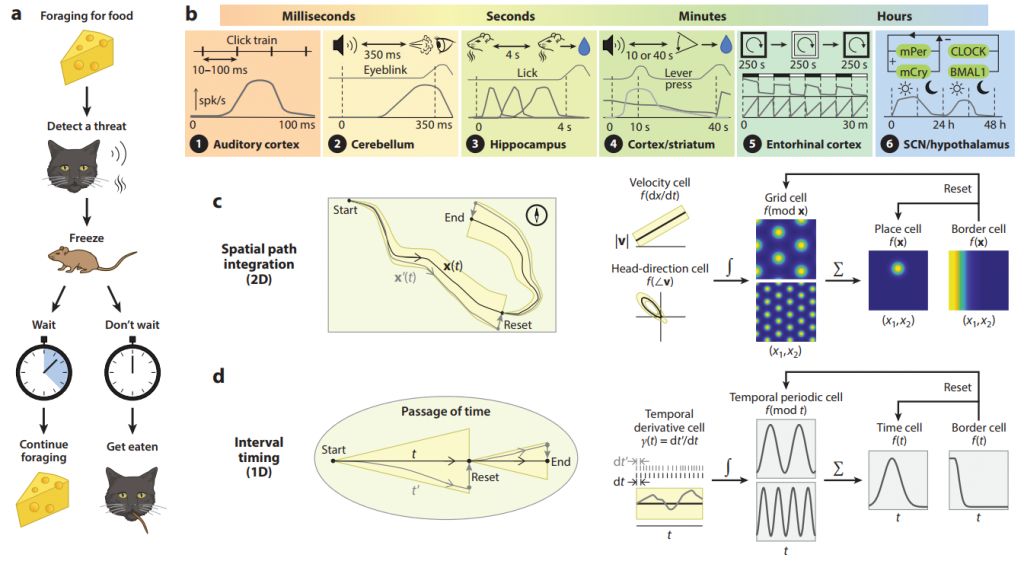
How May the Brain Encode Time from A Spatial Navigation Perspective?
John B. Issa, Gilad Tocker, Michael E. Hasselmo, James G. Heys, Daniel A. Dombeck. Navigating Through Time: A Spatial Navigation Perspective on How the Brain May Encode Time. Annual Review of Neuroscience 2020 43:1
Abstract
“Interval timing, which operates on timescales of seconds to minutes, is distributed across multiple brain regions and may use distinct circuit mechanisms as compared to millisecond timing and circadian rhythms. However, its study has proven difficult, as timing on this scale is deeply entangled with other behaviors. Several circuit and cellular mechanisms could generate sequential or ramping activity patterns that carry timing information. Here we propose that a productive approach is to draw parallels between interval timing and spatial navigation, where direct analogies can be made between the variables of interest and the mathematical operations necessitated. Along with designing experiments that isolate or disambiguate timing behavior from other variables, new techniques will facilitate studies that directly address the neural mechanisms that are responsible for interval timing.”

Fig Scales of neural timing and analogy to spatial navigation (from John B. Issa et al. 2020)
John B. Issa, Gilad Tocker, Michael E. Hasselmo, James G. Heys, Daniel A. Dombeck. Navigating Through Time: A Spatial Navigation Perspective on How the Brain May Encode Time. Annual Review of Neuroscience 2020 43:1
About
Brain Inspired Navigation Blog
New discovery worth spreading on brain-inspired navigation in neurorobotics and neuroscience
Recent Posts
- How human, animals, robots encode and recall place?
- How the brain constructs time and space and how these are related to episodic memory?
- How environmental novelty modulate rapid cortical plasticity during navigation?
- How the Hippocampal Cognitive Map Supports Flexible Navigation?
- How the geometric structure and underlying circuit organization of hippocampal population dynamics facilitate both memory discrimination and generalization, enabling efficient and flexible learning?
Tags
Categories
- 3D Movement
- 3D Navigation
- 3D Path Integration
- 3D Perception
- 3D SLAM
- 3D Spatial Representation
- AI Navigation
- Bio-Inspired Robotics
- Brain Inspired Localization
- Brain-Inspired Navigation
- Cognitive Map
- Cognitive Navigation
- Episodic Memory
- Excerpt Notes
- Flying Vehicle Navigation
- Goal Representation
- Insect Navigation
- Learning to Navigate
- Memory
- Neural Basis of Navigation
- Path Integration
- Path Planning
- Project
- Research Tips
- Robotic Vision
- Self-Flying Vehicles
- Semantic Memory
- Spatial Cognition
- Spatial Cognitive Computing
- Spatial Coordinate System
- Spatial Learning
- Spatial Memory
- Spatial Resoning
- Time
- Unclassified
- Visual Cortex
- Visual Cue Cells
Links
- Laboratory of Nachum Ulanovsky
- Jeffery Lab
- BatLab
- The NeuroBat Lab
- Taube Lab
- Laurens Group
- Romani Lab
- Moser Group
- O’Keefe Group
- DoellerLab
- MilfordRobotics Group
- The Space and Memory group
- Angelaki Lab
- Spatial Cognition Lab
- McNaughton Lab
- Conradt Group
- The Fiete Lab
- The Cacucci Lab
- The Burak Lab
- Knierim Lab
- Clark Spatial Navigation & Memory Lab
- Computational Memory Lab
- The Dombeck Lab
- Zugaro Lab
- Insect Robotics Group
- The Nagel Lab
- Basu Lab
- Spatial Perception and Memory lab
- The Neuroecology lab
- The Nagel Lab
- Neural Modeling and Interface Lab
- Memory and Navigation Circuits Group
- Neural Circuits and Memory Lab
- The lab of Arseny Finkelstein
- The Epstein Lab
- The Theoretical Neuroscience Lab
- Gu Lab (Spatial Navigation and Memory)
- Fisher Lab (Neural Circuits for Navigation)
- The Alexander Lab (Spatial Cognition and Memory)
- Harvey Lab (Neural Circuits for Navigation)
- Buzsáki Lab
- Brain Computation & Behavior Lab
- ……